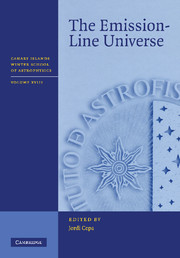Book contents
- Frontmatter
- Contents
- List of contributors
- List of participants
- Preface
- Acknowledgements
- 1 What can emission lines tell us?
- 2 The observer's perspective: Emission-line surveys
- 3 The astrophysics of early galaxy formation
- 4 Primeval galaxies
- 5 Active galactic nuclei
- 6 Chemical evolution
- 7 Galactic sources of emission lines
- 8 Narrow-band imaging
- 9 Long-slit spectroscopy
- 10 Basic principles of tunable filters
Preface
Published online by Cambridge University Press: 23 November 2009
- Frontmatter
- Contents
- List of contributors
- List of participants
- Preface
- Acknowledgements
- 1 What can emission lines tell us?
- 2 The observer's perspective: Emission-line surveys
- 3 The astrophysics of early galaxy formation
- 4 Primeval galaxies
- 5 Active galactic nuclei
- 6 Chemical evolution
- 7 Galactic sources of emission lines
- 8 Narrow-band imaging
- 9 Long-slit spectroscopy
- 10 Basic principles of tunable filters
Summary
Emission lines are powerful means to detect faint objects and to study their composition and physical properties. Detecting and studying objects ranging from galactic sources to the most distant galaxies is made possible by using these lines. The aim of the XVIII Winter School is to give a thorough introduction to this emission-line Universe from both theoretical and observational points of view. For this reason, the Winter School contents include not only classical lectures, but also tutorials on data reduction and analysis. This structure enables young researchers to participate actively in current and future research projects, while serving also as a reference book for experienced researchers.
The subject of this School was motivated by the upcoming advent of a new generation of wide-field instruments for large telescopes, specifically optimized for observing emission-line objects in two dimensions. These instruments will boost the study of these kinds of objects by providing large amounts of data, whose digestion will require a theoretical basis as well as specific data-reduction techniques. These powerful facilities will enable the study of very faint emission lines of nearby objects, or conspicuous lines of very distant targets. The former will provide finer details on the chemical composition and characteristics of the gas, while the latter will furnish insight on structure formation and its evolution via scanning of large proper volumes of Universe.
Most cosmological surveys have been based on the continuum emission of the objects of the Universe via broadband imaging and their spectroscopic follow-up.
- Type
- Chapter
- Information
- The Emission-Line Universe , pp. xiPublisher: Cambridge University PressPrint publication year: 2008

